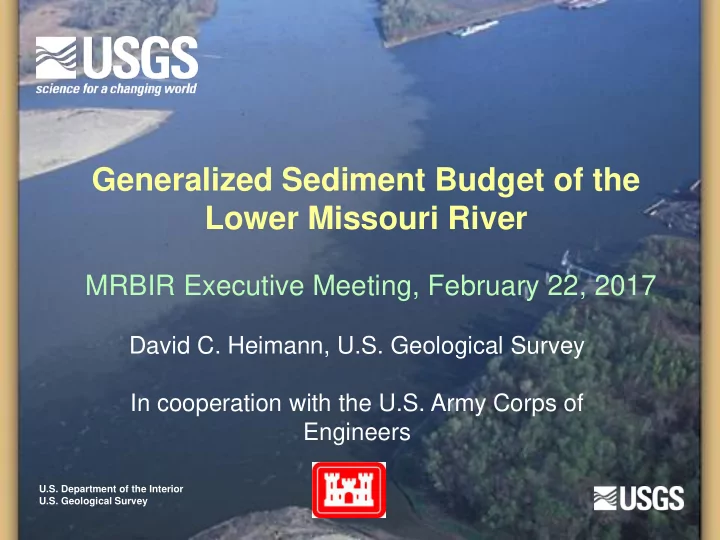

Generalized Sediment Budget of the Lower Missouri River MRBIR Executive Meeting, February 22, 2017 David C. Heimann, U.S. Geological Survey In cooperation with the U.S. Army Corps of Engineers U.S. Department of the Interior U.S. Geological Survey
Impetus for Study “ Corps of Engineers and the U.S. Geological Survey scientists have been conducting valuable collaborative investigations of Missouri River sedimentary processes that should be used as the foundations for a more detailed and extensive sediment budget. Over time, continued collaboration may lead to a more formal program for data collection and evaluation. The Corps and the USGS should extend their collaborative efforts and develop a detailed Missouri River sediment budget for the headwaters to the river’s mouth, with provisions for continuing revisions and updates as new data become available .” -National Research Council, 2011 National Research Council, 2011. Missouri River planning: Recognizing and incorporating sediment management. National Academies Press, Washington D.C., 152 pp.
Why is a Sediment Budget Important? The sediment budget of a reach determines physical channel form ‘ Resistance forces Driving forces (Inputs + Gains) – (Outputs + Losses) = Residual Residual = 0, Equilibrium Residual < 0, Degrading Residual > 0 Aggrading
Why is a Sediment Budget Important?
Why is a Sediment Budget Important? Quantifying sources of sediment in a budget also is a means of determining effectiveness of erosion and nutrient runoff reduction and targeting effective management activities
Objectives of Study — A Starting Point Using existing information, establish the initial framework for a sediment budget with which to update the National Research Council (2011) conceptual sediment budget (Lower Missouri River, post-impoundment period). When and where possible, incorporate bedload transport into the generalized sediment budget.
Sediment Sample Collection Objective – Collect samples representative of sediment concentration over entire cross section Suspended sediment concentrations can vary 500 to 1000 percent from top to bottom and bank to bank Equal-Discharge Increment samples Depth-Integrated samples
Equal-Discharge Increment Sample Collection Discharge measurement needed Break up discharge into 4-7 equal increments Find horizontal center of each increment Collect depth- integrated sample at each increment center
Sediment-Load Categories >90% Suspended (70-90+%) load Unsampled Bedload
Sediment Budget — Temporal and Spatial Scales Geographic (reach, segment, basin) Temporal (daily, monthly, annual, long-term period of record)
Components of Sediment Budget Tributaries, Floodplain/ Erosion from channel floodplain , deposition MRRP activities Dredging Yankton 1 Sioux City Control Volume 2 53 – 268 mi Equilibrium — input + gains = output + losses Omaha 3 Degradation — input + gains< output + losses Aggradation — input + gains > output + losses Nebraska City 4 St. Joseph Hermann 5 6 7 Kansas City St. Louis
Suspended-Sediment Data Availability, 1968-2014 Annual loads Upstream 1 2 33 stations 3 8 Missouri River main 4 stem 5 23 tributaries 2 MS River 6 sites with 22 stations stations complete 6 <50% record record Downstream 7
Suspended-Sediment Data Availability Daily loads Upstream 1 2 3 4 5 6 Downstream 7
Sediment Data Availability Bedload Upstream 1 2 3 4 5 6 Downstream 7
Sediment Budget, 1968-2014, Yankton to Sioux City Inputs James R 330,800 tons 95,600 tons + Gains 1,000,000 tons - MO R Yankton Vermillion R Big Sioux R Losses 330,800 tons 141,000 tons 799,000 tons ? No Data - Output 11,200,000 tons (Inputs +Gains) – (Loss + Outputs) -9,806,000 tons/yr, Residual < 0, Degrading - 87.8% of Sioux City load Bedload ? No data MO R Sioux City 11,200,000 tons
Stage Trends-Gavins Point Dam Tailwaters -7 feet downstream of Gavins Point Dam between 1968-2012
Sediment Budget, 1968-2014, Omaha to Nebraska City IA NE Omaha MO 18,800,000 tons KS Platte R 11,100,000 tons Inputs + Gains – Outputs+Losses -513,000 tons/yr, -1.7% Bedload? MRRP (2000-09) Nebraska City +137,000 tons/yr 30,200,000 tons Other Losses?
Long-term (1968-2014) Budget Residuals Reach Residual 1 Gavins Point to Sioux City -87.8% 2 Sioux City to Omaha -9.2% 3 Omaha to Nebraska City -1.7% 4 Nebraska City to St. Joseph 4.0%* 5 St. Joseph to Kansas City -4.9%* 6 Kansas City to Hermann 0.1%* 7 Hermann to St. Louis -6.9% *Includes bedload estimate
Annual Variability in Sediment Budget Residuals, Omaha to Nebraska City, 1968-2014
Daily Variability in Sediment Budget Residuals, Omaha to Nebraska City, 1968-1976
Sediment Budget Data Gaps Tributary data Bedload? Tributary sediment loads Bank erosion/channel storage? Flood-plain erosion/storage? Flood-plain/Channel storage losses? Sediment gains from bank erosion?
Surrogates and Technological Advancements in Sediment Monitoring Continuous turbidity LISST-SL (real time particle size)
Time-lagged Multi-beam Surveys for Determining Bedload Transport Huizinga (2015)
Questions? Contact: David C. Heimann Hydrologist Meade (1995) U.S. Geological Survey 401 NW Capital Drive Lee’s Summit, MO 64086 816-554-3489 x 206 dheimann@usgs.gov NRC (2011) https://pubs.er.usgs.gov/publication/sir20165097
Recommend
More recommend